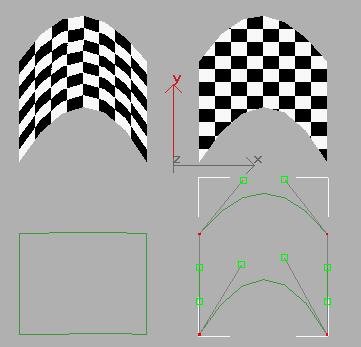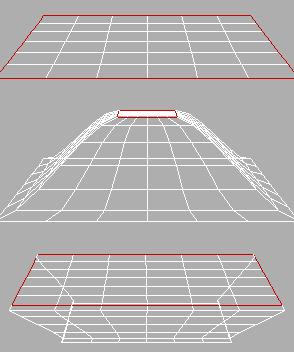

Select an editable patch. > Modify panel > Expand the editable patch in the stack display. > Patch sub-object level
Select an editable patch. > Modify panel > Selection rollout > Patch button
Select an editable patch. > Right-click the patch > Tools 1 (upper-left) quadrant of the quad menu > Sub-objects > Patch
A patch is an area of a patch object, defined by three or four surrounding edges and vertices. Controls described in this topic let you manipulate a patch object at the patch level. As well as moving and rotating patches, you can create a separate element by holding down the SHIFT key during a move operation. This creates a separate element of the selected patches.
Patches can be mapped in curved space; this means simplified texture mapping for patches. A planar map on a complex patch object will not be distorted. At the Patch sub-object level there is a parameter in the right-click quad menu (Tools 1 quadrant) called Linear Mapping. If you leave Linear Mapping off, then textures are interpolated in curved space and behave much like texture mapping a mesh object, predictably.
In the old method, patch mapping is interpolated between the knot points. This works well with procedural maps but not so well with bitmaps, since each patch is linear in UV space.

A complex patch (on right) no longer deforms a bitmap
The two leftmost patches show Linear patch mapping. The top left patch is a patch with planar mapping and the bottom left shows its UVW space representation. The patch on the right is a curved projection where the vectors are used in UVW space projection. Notice the bottom right represents the UVW space and notice how the handles and knots contribute to the shape of the UVW space.
In short, leave the Linear option off for predictable planar maps. Leave the linear mapping option on for backward compatibility.
Note: The UVW Unwrap modifier now supports the new patch curve mapping. Spline handles can be manipulated in the Edit dialog in the UVW Unwrap modifier.
Interface
Selection rollout
See Editable Patch for information on the Selection rollout settings.
Soft Selection rollout
See Soft Selection Rollout for information on the Soft Selection rollout settings.
Geometry rollout

Subdivision group
Subdivide: Subdivides selected patches. Select one or more patches, and then click Subdivide.
Propagate: When on, extends the subdivision to neighboring patches. Propagating the subdivisions along all contiguous patches prevents patch cracks where you have attached patches together.
Topology group
Create: Creates a three or four-sided patch on existing geometry or in free space. First turn on Create and then click on geometry or free space in the viewports to create a quad or a tri patch.
Patch vertices are selected by left clicking on existing vertices. Left clicking in free space creates a new vertex at that location. If you digitize away from an existing vertex then a new vertex is created and it will be included in the sequence of vertices for the new patch. The cursor changes to a white cross hair when selecting an existing vertex.
To create a Tri Patch: Click three times in free space or on existing vertices. Right-click, or left-click on one of the vertices in the current sequence to complete the creation of a Tri Patch.
To create a Quad Patch: Click four times in free space or on existing vertices. The Quad Patch will be automatically created after the fourth click.
No operation will take place if you right-click or select a vertex in the current sequence when only one or two vertices are in the sequence.
Detach: Lets you select one or more patches within the current object and then detach them (or copy them) to form a separate patch object.
Reorient: When on, the detached patch copies the position and orientation of the source object's creation Local coordinate system. The new detached object is moved and rotated so that its Local coordinate system is positioned and aligned with the origin of the current active grid.
Copy: When on, the detached patches are copied to a new patch object, leaving the originals intact.
Attach: Lets you attach an object to the currently selected patch object. Click the object you want to attach to the currently selected patch object.
For further details, see Attach.
Reorient: When on, reorients the attached patch so that each patch's creation local coordinate system is aligned with the creation local coordinate system of the selected patch.
Delete: Deletes the selected patch or patches.
Hide: Hides selected patches.
Unhide All: Restores any hidden sub-objects to visibility.
Extrude & Bevel group
These controls let you extrude and bevel patches. Extruding patches moves them along a normal and creates new patches that form the sides of the extrusion, connecting the selection to the object. Beveling adds a second step that lets you scale the extruded patches. You can extrude and bevel patches by dragging or by direct entry. You can also hold down the SHIFT key during extrusion, which creates a separate element.
Note: Sides created by beveling or extrusion are assigned to smoothing group 1.
Extrude: Click this button, and then drag any patch to extrude it interactively. Hold down the SHIFT key during this operation to create a new element.
When the mouse cursor is over a selected patch, it changes to an Extrude cursor.
With multiple patches selected, dragging on any one extrudes all selected patches equally.
You can drag other patches in turn to extrude them while the Extrude button is active. Click Extrude again or right-click to end the operation.
Bevel: Click this button, and then drag any patch to extrude it interactively, then click and release the mouse button, and drag again to bevel the extrusion. Hold down the SHIFT key during this operation to create a new element.
When the mouse cursor is over a selected patch, it changes to a Bevel cursor.
With multiple patches selected, dragging on any one bevels all selected patches equally.
You can drag other patches in turn to bevel them while the Bevel button is active. Click Bevel again or right-click to end the operation.

Original patch (top) and inward and outward extrusions
Extrusion: This spinner lets you extrude selected patches outward or inward, depending on whether the value is positive or negative.
Outlining: This spinner lets you scale selected patches bigger or smaller, depending on whether the value is positive or negative. It is normally used after an extrusion for beveling the extruded patches.
Normal: With Normal set to Group, extrusion takes place along the averaged normal of each contiguous group of patches. If you extrude multiples of such groups, each group moves along its own averaged normal. If Normal is set to Local (the default), extrusion takes place along each selected patch's normal.
Bevel Smoothing: These settings let you set the shape of the intersection between the surface created by a beveling operation and the neighboring patches. The shapes are determined by the handle configurations of vertices at the intersections. Start refers to the intersection between the sides and the patches surrounding the beveled patch. End refers to the intersection between the sides and the beveled patch or patches. The following settings are available for each:
Smooth: Vertex handles are set so the angles between the new patches and their neighbors are relatively small.
Linear: Vertex handles are set to create linear transitions.
None: Vertex handles are not modified.
Warning: Set Bevel Smoothing before the bevel is performed; changing the setting has no effect on existing beveled patches.
Surface group
View Steps: Controls the grid resolution of the patch model surface as depicted in the viewports.
Show Interior Edges: Enables the display of the patch object's interior edges in wireframe views. When off, only the object's outline is visible. Turn on to simplify the display for faster feedback.
Surface Properties rollout

These controls let you work with patch normals, material IDs, smoothing groups and vertex colors.
Normals group
Flip: Reverses the direction of the surface normals of the selected patches.
Unify: Flips the normals of an object so that they all point in the same direction, usually outward. This is useful for setting an object's patches to appropriate orientations, thus eliminating apparent holes in the object surface.
Flip Normal Mode: Flips the normal of any patch you click. To exit, click this button again or right-click anywhere in the program interface.
Tip: The best way to use Flip Normal Mode is to set up your viewport to display with Smooth+Highlight and Edged Faces turned on. If you use Flip Normal Mode with default settings, you'll be able to flip a patch away from you, but you won't be able to flip it back. For best results, turn off Ignore Backfacing in the Selection rollout. This lets you click any patch and flip the direction of its normal, regardless of its current direction.
Material group
These controls let you use multi/sub-object materials with patches.
ID: Lets you assign a particular material ID number to selected patches for use with multi/sub-object materials and other applications. Use the spinner or enter the number from the keyboard. The total number of available IDs is 65,535.
Select by ID: Displays a dialog for you to enter a material ID number. Clicking OK selects the patches assigned that material ID. If Clear Selection is on, any previously selected patches are first deselected. If Clear Selection is off, the new selection is added to any previous selection set.
Smoothing Groups group
Use these controls to assign selected patches to different smoothing groups, and to select patches by smoothing group.
To assign patches to one or more smoothing groups, select the patches, and then click the number(s) of the smoothing group(s) to assign them to.
Select by SG (Smoothing Group): Displays a dialog that shows the current smoothing groups. Select a group by clicking the corresponding numbered button and clicking OK.
Clear All: Removes any smoothing group assignments from selected patches.
Edit Vertex Colors group
Use these controls to assign the color, illumination color (shading), and alpha (transparency) values of vertices on the selected patch(es).
Color: Click on the color swatch to change the color of vertices on the selected patch(es).
Illumination: Click on the color swatch to change the illumination color of vertices on the selected patch(es). This lets you change the color of shadows without changing the vertex colors.
Alpha: Lets you assign an alpha (transparency) value to vertices on the selected patch(es).
The spinner value is a percentage; zero is completely transparent and 100 is completely opaque.